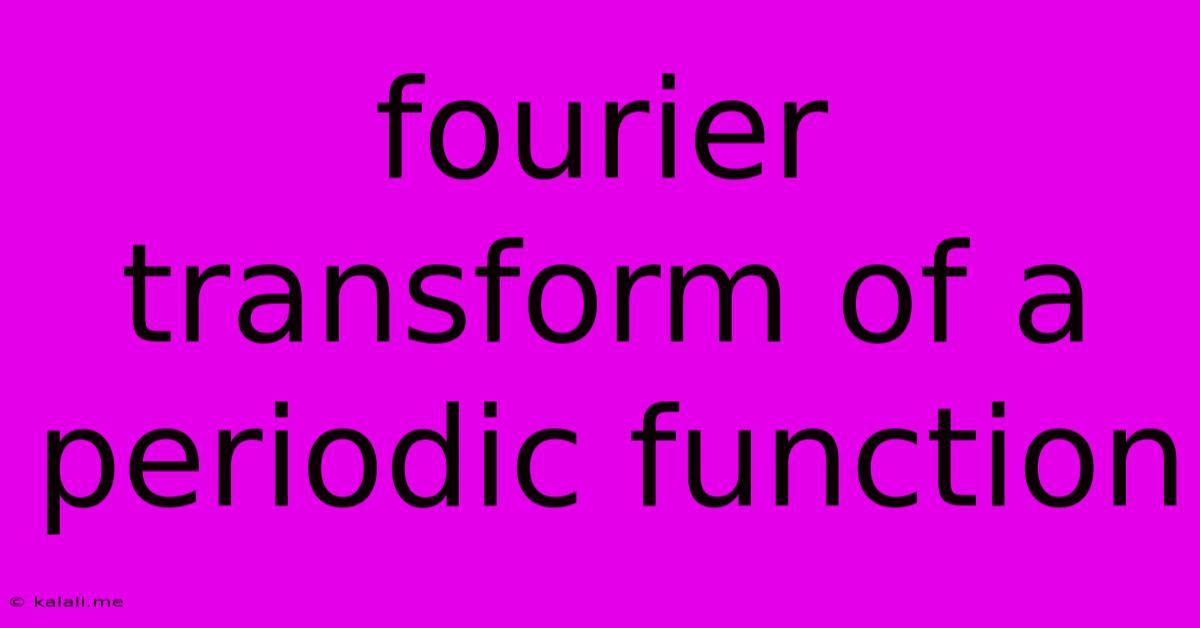Fourier Transform Of A Periodic Function
Kalali
Jun 05, 2025 · 3 min read

Table of Contents
The Fourier Transform of a Periodic Function: Unpacking the Secrets of Repeating Signals
The Fourier transform is a powerful mathematical tool used to decompose a function into its constituent frequencies. While often applied to aperiodic functions, understanding its application to periodic functions reveals crucial insights into the nature of repeating signals and their spectral representation. This article will delve into the intricacies of the Fourier transform of a periodic function, exploring its properties and practical applications. This guide will cover the core concepts in a clear and accessible manner, perfect for students and professionals alike.
What is a Periodic Function?
A periodic function is a function that repeats its values at regular intervals. Mathematically, a function f(t) is periodic with period T if f(t + T) = f(t) for all t. Think of a sine wave or the rhythmic ticking of a clock – these are prime examples of periodic phenomena. Understanding their frequency content is vital in many fields, from signal processing to quantum mechanics.
The Fourier Series: The Foundation
For periodic functions, the Fourier series provides a powerful way to express the function as a sum of harmonically related sine and cosine waves. The Fourier series representation of a periodic function f(t) with period T is given by:
f(t) = a₀/2 + Σ[aₙcos(2πnt/T) + bₙsin(2πnt/T)]
where:
- a₀, aₙ, and bₙ are the Fourier coefficients, determined by integrals involving f(t).
- n is an integer representing the harmonic number.
Each term in the series represents a specific frequency component, a multiple of the fundamental frequency (1/T). This decomposition allows us to analyze the frequency content of the periodic signal, identifying dominant frequencies and their relative amplitudes.
Connecting the Fourier Series to the Fourier Transform
While the Fourier series works beautifully for periodic functions, the Fourier transform is designed for aperiodic functions. However, we can leverage the concept of the Fourier series to understand the Fourier transform of a periodic function.
Consider a periodic function with period T. If we take a single period of this function and treat it as an aperiodic function, we can apply the Fourier transform. The resulting Fourier transform will show the frequency components present within that single period.
Because the function is periodic, the frequencies present in the single period will repeat at intervals of 1/T in the frequency domain. This means that the Fourier transform of a periodic function isn't a continuous function but instead a series of impulses at specific frequencies, mirroring the discrete frequencies present in the Fourier series.
Key Properties and Implications
-
Discrete Spectrum: The Fourier transform of a periodic function yields a discrete spectrum, with peaks at integer multiples of the fundamental frequency. This contrasts sharply with the continuous spectrum obtained from the Fourier transform of an aperiodic function.
-
Impulse Function Representation: The spectral representation is often described using Dirac delta functions (impulse functions), representing the concentration of energy at specific frequencies.
-
Frequency Analysis: The heights of these impulses correspond to the amplitudes of the different frequency components, offering a precise frequency analysis of the periodic signal.
Applications in Various Fields:
The Fourier transform of periodic functions finds widespread use in numerous fields, including:
-
Signal Processing: Analyzing and filtering periodic signals, such as audio waves or electrical signals.
-
Image Processing: Decomposing images into frequency components for image compression and enhancement.
-
Physics and Engineering: Studying oscillatory systems and analyzing periodic phenomena in mechanics, optics, and electromagnetism.
Conclusion:
The Fourier transform of a periodic function, while seemingly a niche topic, is fundamental to understanding the spectral properties of repetitive signals. Through the lens of the Fourier series and the concept of discrete frequencies, we can gain valuable insights into the frequency composition of such functions, a knowledge crucial for advancements in countless scientific and engineering disciplines. By understanding this relationship, you can unlock a deeper comprehension of signal processing and the underlying mathematical framework of periodic phenomena.
Latest Posts
Latest Posts
-
Zip R Recursive Files In Folder
Jun 06, 2025
-
Why Do My Cats Like To Play Wrestle
Jun 06, 2025
-
Can 2 Circuits Share A Neutral
Jun 06, 2025
-
What Have Been You Up To
Jun 06, 2025
-
Are We All Descendants From Noah
Jun 06, 2025
Related Post
Thank you for visiting our website which covers about Fourier Transform Of A Periodic Function . We hope the information provided has been useful to you. Feel free to contact us if you have any questions or need further assistance. See you next time and don't miss to bookmark.